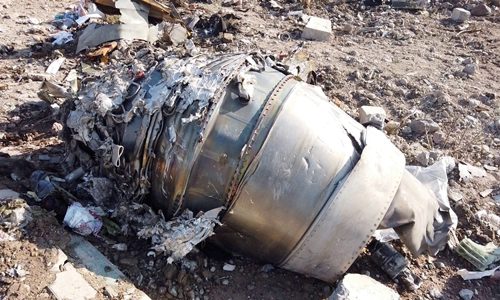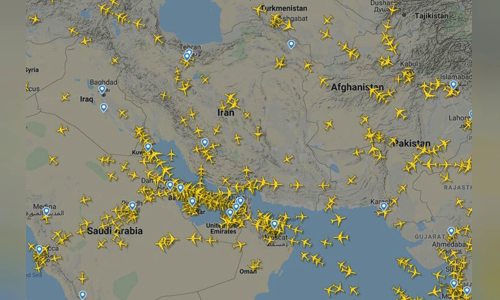The lack of international regulations on airspace closure has allowed Ukrainian aircraft to remain in flight only hours after Iran raided the missile.
Although Iran's Islamic Revolutionary Guards (IRGC) dawned on January 8 to launch 22 missiles at two US military bases in Iraq to avenge General Qassem Soleimani, the country's civil aviation agency remained open. airspace, which resulted in a tragedy of a Ukrainian plane carrying 176 people mistakenly shot hours later.

Broken Ukrainian aircraft crashed in Iran on January 8 Photo: Reuters
According to experts, one of the main causes of the tragedy is that the aviation industry has no international agreement on the circumstances when a country must declare the airspace closed. In the event of a risk of war, airlines often have to rely on their own judgment to decide whether or not to take off.
Although the aviation industry operates with interconnected global networks and instantaneous electronic data streams, the control of each nation's airspace is entirely their own decision and depends largely on factors. politic.
Iran itself suffered a similar tragedy in 1988, when the US warship USS Vincennes shot down an Iran Air passenger plane in 1988, killing 290 people. In 2014, Malaysia Airlines MH17 aircraft was hit by a rocket flying over a war zone in eastern Ukraine, where pro-Russian separatists are fighting government troops.
This incident led the International Civil Aviation Organization (ICAO) to set up a website listing areas of conflict identified as dangerous to civil aviation. However, this idea is not effective.
This publication of information about a nation's airspace is politically sensitive, and could be considered an intervention in sovereignty. There is also doubt about how the ICAO verifies the information, forcing the organization to give countries 72 hours to respond if it finds information about "dangerous airspace" is incorrect.
In 1985, Iraq declared that civil aircraft should not enter Iranian airspace. But Iraq and Iran were at the time of the war and this move sparked fierce debate at ICAO.
In 2015, the Netherlands, where two-thirds of victims on MH17, urged ICAO to set standards when airspace closures were needed, but changes were not yet implemented.
Since 290 people on Iran Air 655 crashed, more than 750 people have been killed worldwide in attacks on civil aircraft in various forms, according to Flight Safety Organization data. fly. "The practice shows that countries in armed conflict do not restrict their airspace," the Netherlands Safety Commission report said last year.
An Iranian military commander said at the end of last week that before launching a missile strike on two US bases in Iraq, the Iranian military had asked the government to ban the flight of airspace in Tehran, but was denied. It is unclear why this requirement was not met, but the flight ban in Tehran could be a warning of the impending attack, losing the surprise element of the raid.

The aircraft in the Middle East sky midday 15/1 Photo: Flightradar24
The lack of uniform regulations on the closure of airspace has forced airlines and other regulatory bodies to self-assess risks. However, each assessment depends on different intelligence and sometimes inadequate. Not all regulators have equal authority to prevent airlines from flying over conflict areas.
Ukraine International Airlines said it did not receive a warning from Tehran before the PS752 flight took off and there was no reason to prevent the plane from taking off. It was the 10th departure from Tehran airport that morning, according to FlightRadar24.
Although the Middle East is a place of frequent conflict, the airspace of this region plays an important role in the East-West corridor. Airlines face intense competition, increasing economic and environmental pressures, so they have to save fuel by flying the most straight routes possible, many of which cross the line. Middle East sky.
Ron Bartsch, who used to be the head of safety at Qantas Airways, said airlines rarely wanted to choose a roundabout route because of cost.
Three days after the US air strike killed Iranian General Qassem Soleimani and the day before Tehran's retaliatory attack, about 1,000 flights flew over Iran and Iraq, according to the International Air Transport Association (IATA).
None of these flights, however, are from US airlines. The Federal Aviation Administration banned its carriers from operating in Iranian airspace after Tehran shot down a U.S. drone in June 2019.
But other countries do not assess risks the same way. IATA, representing global airlines, said it would improve those ratings. A source said ICAO was seeking to promote liaison between the government and the military, to prevent a tragedy from recurring.
Oleksiy Danylov, secretary of Ukraine's National Defense and Security Council, said that Kiev would begin its effort to create a new global civil aviation risk warning system. Those who frequently travel by plane will hope they have better luck than those who have tried and failed.



 ImaneAitEl
ImaneAitEl







